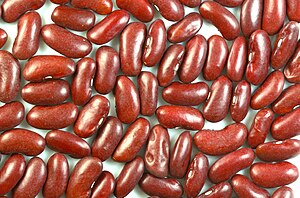Kidney bean
 Uncooked red kidney beans | |
| Nutritional value per 100 g (3.5 oz) | |
|---|---|
| Energy | 1,393 kJ (333 kcal) |
60 g | |
| Sugars | 2 g |
| Dietary fiber | 15 g |
1 g | |
24 g | |
| Vitamins | Quantity %DV† |
| Pantothenic acid (B5) | 16% 0.8 mg |
| Folate (B9) | 99% 394 μg |
| Minerals | Quantity %DV† |
| Calcium | 11% 143 mg |
| Iron | 44% 8 mg |
| Magnesium | 33% 140 mg |
| Potassium | 47% 1406 mg |
| Zinc | 27% 3 mg |
| Other constituents | Quantity |
| Water | 12 g |
| †Percentages estimated using US recommendations for adults,[1] except for potassium, which is estimated based on expert recommendation from the National Academies.[2] | |
The kidney bean is a variety of the common bean (Phaseolus vulgaris). It is named for its visual resemblance in shape and color to a kidney. Red kidney beans can be confused with other beans that are red, such as adzuki beans. In Jamaica, they are called "red peas".
Classification
- Red kidney bean (also known as: common kidney bean).
- Light speckled kidney bean (and long shape light speckled kidney bean).
- Red speckled kidney bean (and long shape light speckled kidney bean).
- White kidney bean (also known as cannellini).[3]
The dishes
Red kidney beans are commonly used in chili con carne and are an integral part of the cuisine in northern regions of India and Pakistan, where the beans are known as rajma and are used in a dish of the same name. Red kidney beans are used in New Orleans and much of southern Louisiana for the classic Monday Creole dish of red beans and rice. The smaller, darker red beans are also used, particularly in Louisiana families with a recent Caribbean heritage. Small kidney beans used in La Rioja, Spain, are called caparrones.
Toxicity
Kidney beans are more toxic than most other bean varieties if not pre-soaked and subsequently heated to the boiling point for at least 10 minutes. The U.S Food and Drug Administration recommends boiling for 30 minutes to ensure they reach a sufficient temperature long enough to completely destroy the toxin.[4] However, cooking at the lower temperature of 80 °C (176 °F), such as in a slow cooker, can increase this danger and raise the toxin level up to fivefold.[5]
References
- ^ United States Food and Drug Administration (2024). "Daily Value on the Nutrition and Supplement Facts Labels". FDA. Archived from the original on 2024-03-27. Retrieved 2024-03-28.
- ^ National Academies of Sciences, Engineering, and Medicine; Health and Medicine Division; Food and Nutrition Board; Committee to Review the Dietary Reference Intakes for Sodium and Potassium (2019). Oria, Maria; Harrison, Meghan; Stallings, Virginia A. (eds.). Dietary Reference Intakes for Sodium and Potassium. The National Academies Collection: Reports funded by National Institutes of Health. Washington, DC: National Academies Press (US). ISBN 978-0-309-48834-1. PMID 30844154. Archived from the original on 2024-05-09. Retrieved 2024-06-21.
- ^ "Kidney Beans". The world's healthiest foods. Retrieved 2007-11-05.
- ^ "Bad Bug Book (2012)" (pdf). Foodborne Pathogenic Microorganisms and Natural Toxins Handbook: Phytohaemagglutinin. Food and Drug Administration. 2012. Retrieved 26 December 2013.
Consumers should boil the beans for at least 30 minutes to ensure that the product reaches sufficient temperature
- ^ Phytohaemagglutinin. Foodborne Pathogenic Microorganisms and Natural Toxins Handbook, US Food and Drug Administration (2009)
